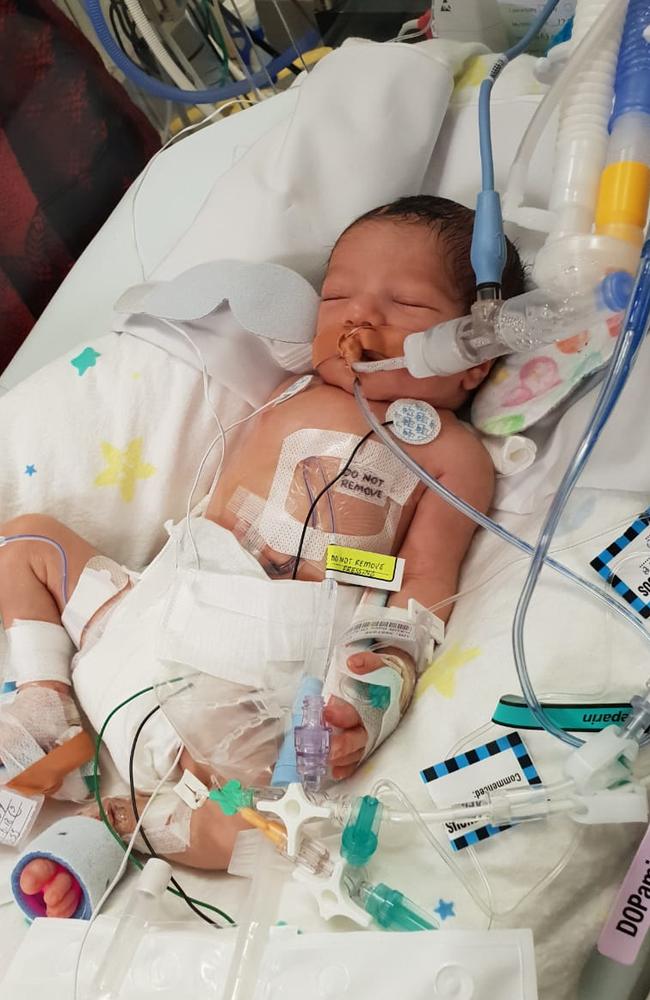Agamveer Singh is lucky to be alive after being born without an oesophagus or an anal hole
One small tube was all that kept tiny battler Agamveer Singh alive after he had to undergo three operations at two Brisbane hospitals by the time he was five months old.
QLD News
Don't miss out on the headlines from QLD News. Followed categories will be added to My News.
Amandeep Kaur cried so loudly in her sleep one night a nurse had to wake her up.
Her 6-month-old son, Agamveer Singh, was in the Paediatric Intensive Care Unit following yet another surgery, leaving him paralysed for 72 hours.
“I couldn’t even believe that (a baby) could go through so many problems,” she said.
“I cried every day and every night after he was born.”
Born without an oesophagus or an anal hole, Agamveer is lucky to be alive.
INSIDE WARD 9B: THE NURSES CARING FOR OUR SICKEST KIDS
‘PART OF HIS INTESTINE WAS COILED LIKE A PEELED APPLE’
The Lawnton toddler was diagnosed with a rare birth defect, called long gap oesophagus atresia with tracheoesophageal fistula – or, without the tube that connects the mouth to the stomach – only weeks before he was born.
Mrs Kaur, 31, said her son’s oesophagus ended in a dead-end, or blind, pouch.
“He was very critical,” she said.
Not able to swallow his own saliva, the now two-year-old had undergone three operations at two Brisbane hospitals by the time he was five months old.
Surgeons inserted a feeding tube and a colostomy bag – where one end of the large intestine is diverted into an opening on the abdomen, with a bag then placed over it to collect faeces – when Agamveer was just a day old.

After spending 10 weeks in the Mater Hospital’s Neonatal Intensive Care Unit, Agamveer was transferred to the babies ward at the Queensland Children’s Hospital on Stanley Street, where he spent another five months.
Even the short transfer was onerous.
“On the way he aspirated saliva,” Mrs Kaur said.
“The next day, I was nearly faint as I saw him going blue, then going yellow, because he had pneumonia.
“I thought many times he was not going to survive, he’d been through that many infections. But, he’s a fighter.”

For many months, a simple, yet sophisticated, tube helped keep little Agamveer alive while he grew big enough to have his surgeries.
“It was very scary,” Mrs Kaur said through tears.
“(The nurses) were doing suctioning with a replogle tube. This helped him to get all of the saliva out as he was not able to do it himself.
“The Ward 9B staff had the expert in the tube, and he always had three or four nurses. If something happened, they’d come together to help him.”
A replogle tube is used to continuously drain saliva from the upper oesophageal pouch, according to the Royal Children’s Hospital of Melbourne.
The drainage helps prevent saliva spilling over into the trachea which could otherwise result in aspiration or pneumonia.

Mrs Kaur said she and her husband, Satwinder Singh, 29, went through some terrifying times, when the replogle tube stopped working.
“Agamveer had been very sick with pneumonia three times,” Mrs Kaur said.
“He had a lot of trouble all the time, all night, with surgeons and doctors coming to see him.”
She said during her then-infant son’s second operation in October 2018, surgeons created an anus.
A month later, he underwent what was thought to be the first of two long operations to construct his oesophagus, when they finally received some good news.
“There was a miracle,” Mrs Kaur sad.
“They found some of his oesophagus rolled up in his stomach.”
This meant the surgeons were able to join the oesophagus together in only one nine-hour operation.
“When they found the oesophagus there was a big relief. We were thanking god,” she said.
“I was crying and crying couldn’t stop crying.”
Agamveer who the nurses dubbed ‘Aggie’, spent more than a month in and out of the Paediatric Intensive Care Unit following the operation.
He then developed a blood clot in his right leg resulting in Mrs Kaur having to give her son special injections twice a day for 12 months.

A few months after Agamveer finally got to go home, he had to return for his final operation in May 2019 to remove the colostomy bag.
To Mrs Kaur’s exasperation, the wound became infected within a day, resulting in another fortnight in hospital.
“He has gone through so much,” she said at the time.
“I do cry a lot. I wake up crying at night.”
Mrs Kaur said she and Mr Singh were grateful to live in Brisbane.
“We are very lucky that we’re here and that my husband and my baby boy are here,” she said.
“If he had been born in my country, there would have been no chance of survival.
“The medical system is good in India, but this is a very rare condition.”
“If he was born in India, even though we would have to sell our house or property, we could not have saved his life.”


